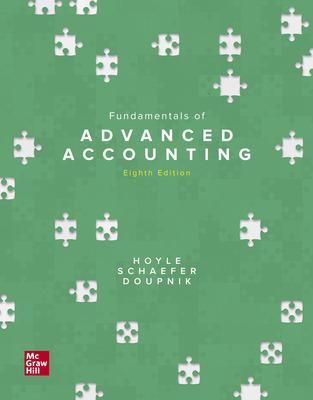Question
Problem 1.) Changes in depreciation methods, estimates. On January 1, 2008, Powell Company purchased a building and machinery that have the following useful lives, salvage
Problem 1.) Changes in depreciation methods, estimates.
On January 1, 2008, Powell Company purchased a building and machinery that have the following useful lives, salvage value, and costs.
Building, 25-year estimated useful life, $5,000,000 cost, $500,000 salvage value
Machinery, 10-year estimated useful life, $700,000 cost, no salvage value
The building has been depreciated under the straight-line method through 2012. In 2013, the company decided to switch to the double-declining balance method of depreciation for the building. Powell also decided to change the total useful life of the machinery to 8 years, with a salvage value of $35,000 at the end of that time. The machinery is depreciated using the straight-line method.
Instructions
(a) Prepare the journal entry necessary to record the depreciation expense on the building in 2013.
(b) Compute depreciation expense on the machinery for 2013.
Problem 2.) Accounting for changes and error corrections.
Dyke Company's net incomes for the past three years are presented below:
2014 2013 2012
$480,000 $450,000 $360,000
During the 2014 year-end audit, the following items come to your attention:
1. Dyke bought equipment on January 1, 2011 for $294,000 with a $24,000 estimated salvage value and a six-year life. The company debited an expense account and credited cash on the purchase date for the entire cost of the asset. (Straight-line method)
2. During 2014, Dyke changed from the straight-line method of depreciating its cement plant to the double-declining balance method. The following computations present depreciation on both bases:
2014 2013 2012
Straight-line 36,000 36,000 36,000
Double-declining 46,080 57,600 72,000
The net income for 2014 was computed using the double-declining balance method, on the January 1, 2014 book value, over the useful life remaining at that time. The depreciation recorded in 2014 was $72,000.
3. Dyke, in reviewing its provision for uncollectibles during 2014, has determined that 1% is the appropriate amount of bad debt expense to be charged to operations. The company had used 1/2 of 1% as its rate in 2013 and 2014 when the expense had been $18,000 and $12,000, respectively. The company recorded bad debt expense under the new rate for 2014. The company would have recorded $6,000 less of bad debt expense on December 31, 2014 under the old rate.
Instructions
(a) Prepare in general journal form the entry necessary to correct the books for the transaction in part 1 of this problem, assuming that the books have not been closed for the current year.
(b) Compute the net income to be reported each year 2012 through 2014.
(c) Assume that the beginning retained earnings balance (unadjusted) for 2012 was $1,260,000. At what adjusted amount should this beginning retained earnings balance for 2012 be stated, assuming that comparative financial statements were prepared?
(d) Assume that the beginning retained earnings balance (unadjusted) for 2014 is $1,800,000 and that non-comparative financial statements are prepared. At what adjusted amount should this beginning retained earnings balance be stated?
Problem 3.) Statement of cash flows (indirect method).
The net changes in the balance sheet accounts of Keating Corporation for the year 2015 are shown below.
Account Debit Credit
Cash $ 72,000
Short-term investments $121,000
Accounts receivable 83,200
Allowance for doubtful accounts 13,300
Inventory 74,200
Prepaid expenses 22,800
Investment in subsidiary (equity method) 25,000
Plant and equipment 220,000
Accumulated depreciation 130,000
Accounts payable 80,700
Accrued liabilities 21,500
Deferred tax liability 15,500
8% serial bonds 70,000
Common stock, $10 par 90,000
Additional paid-in capital 150,000
Retained earningsAppropriation for bonded indebtedness 60,000
Retained earningsUnappropriated 38,000
Total $643,600 $643,600
An analysis of the Retained EarningsUnappropriated account follows:
Retained earnings unappropriated, December 31, 2014 $1,300,000
Add: Net income 327,000
Transfer from appropriation for bonded indebtedness 60,000
Total...... $1,687,000
Deduct: Cash dividends $185,000
Stock dividend 240,000 425,000
Retained earnings unappropriated, December 31, 2015 $1,262,000
1. On January 2, 2015 short-term investments (classified as available-for-sale) costing $121,000 were sold for $155,000.
2. The company paid a cash dividend on February 1, 2015.
3. Accounts receivable of $16,200 and $19,400 were considered uncollectible and written off in 2015 and 2014, respectively.
4. Major repairs of $33,000 to the equipment were debited to the Accumulated Depreciation account during the year. No assets were retired during 2015.
5. The wholly owned subsidiary reported a net loss for the year of $20,000. The loss was recorded by the parent.
6. At January 1, 2015, the cash balance was $166,000
Instructions
Prepare a statement of cash flows (indirect method) for the year ended December 31, 2015. Keating Corporation has no securities which are classified as cash equivalents
Step by Step Solution
There are 3 Steps involved in it
Step: 1

Get Instant Access to Expert-Tailored Solutions
See step-by-step solutions with expert insights and AI powered tools for academic success
Step: 2

Step: 3

Ace Your Homework with AI
Get the answers you need in no time with our AI-driven, step-by-step assistance
Get Started


